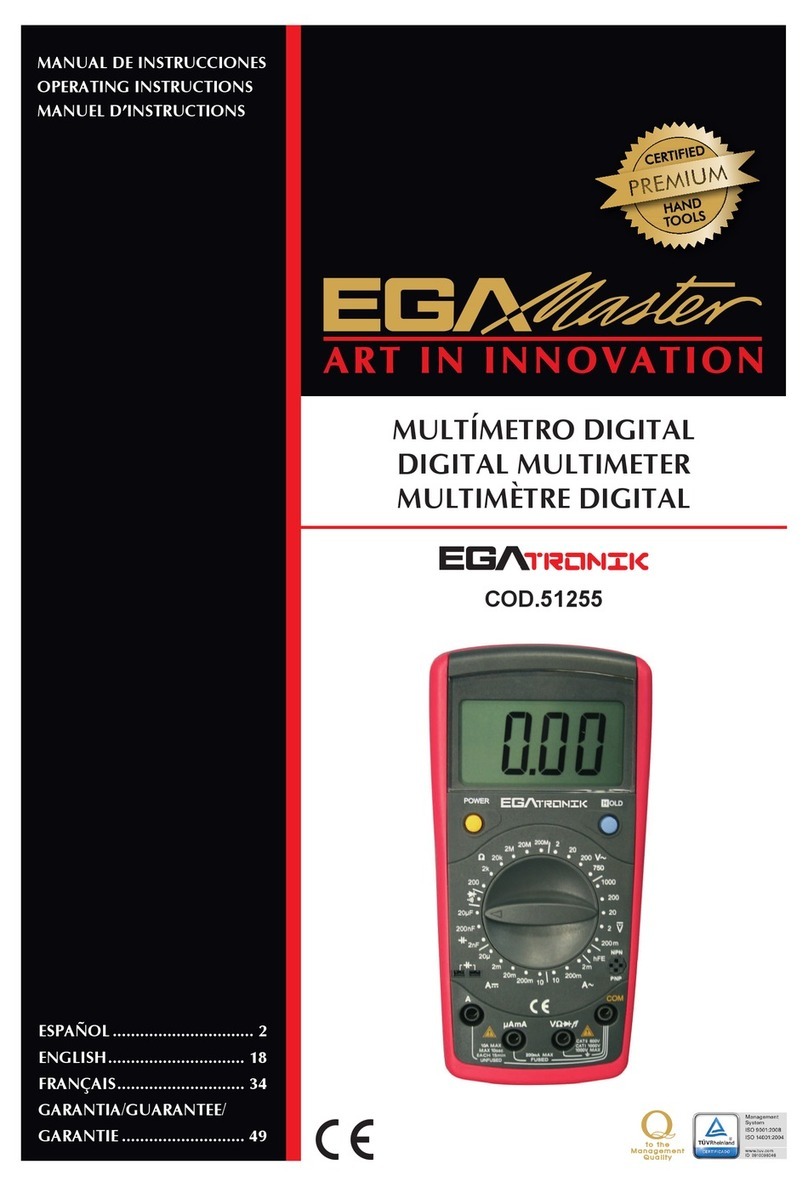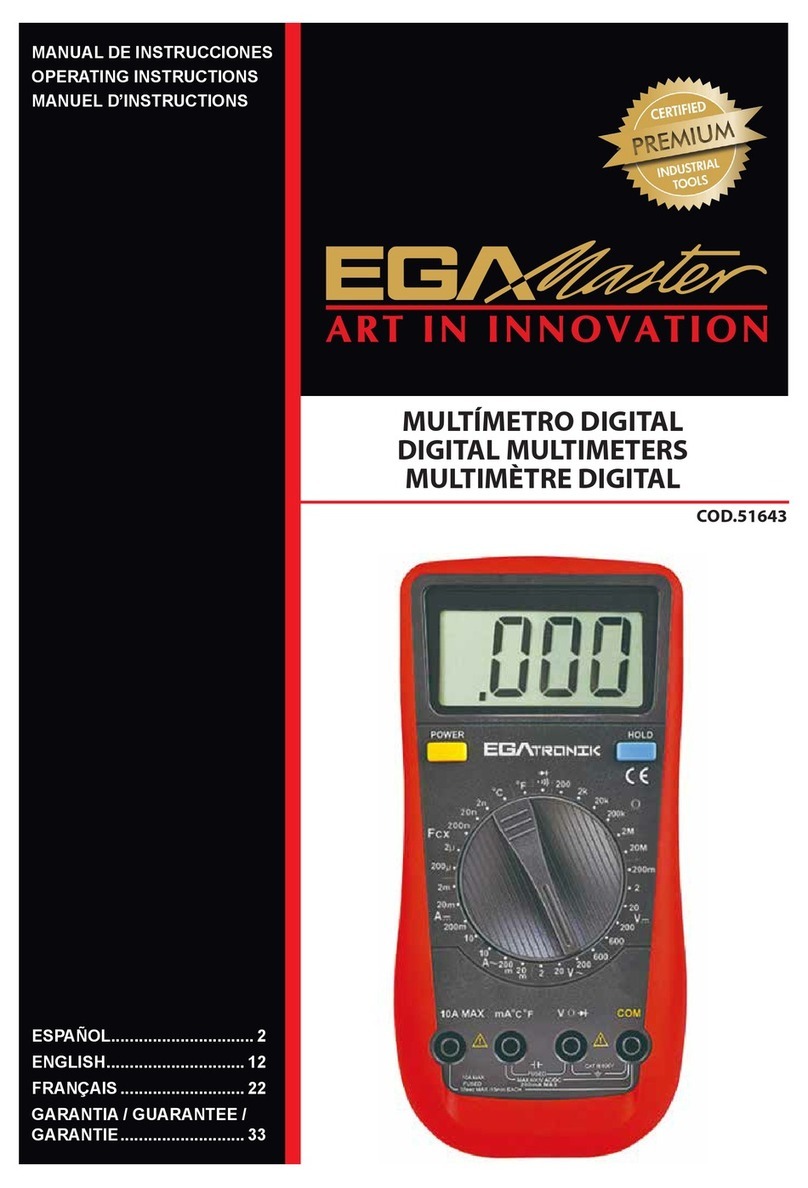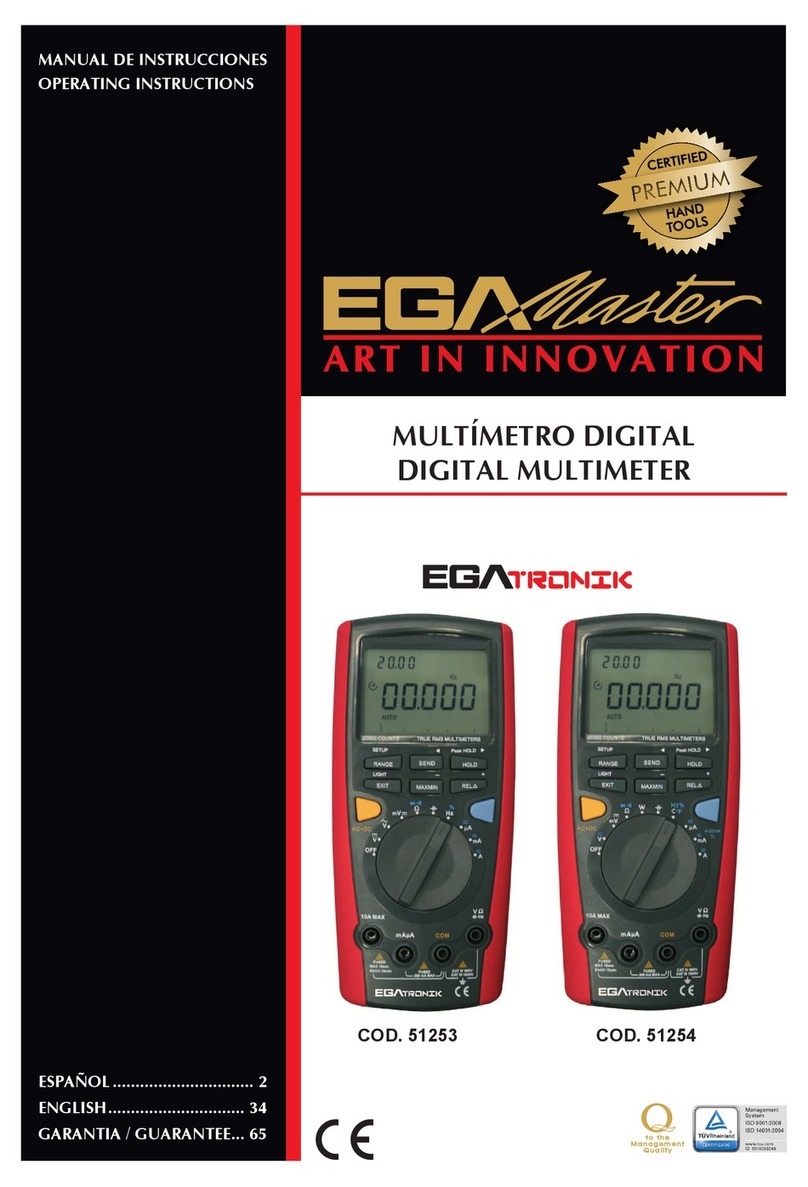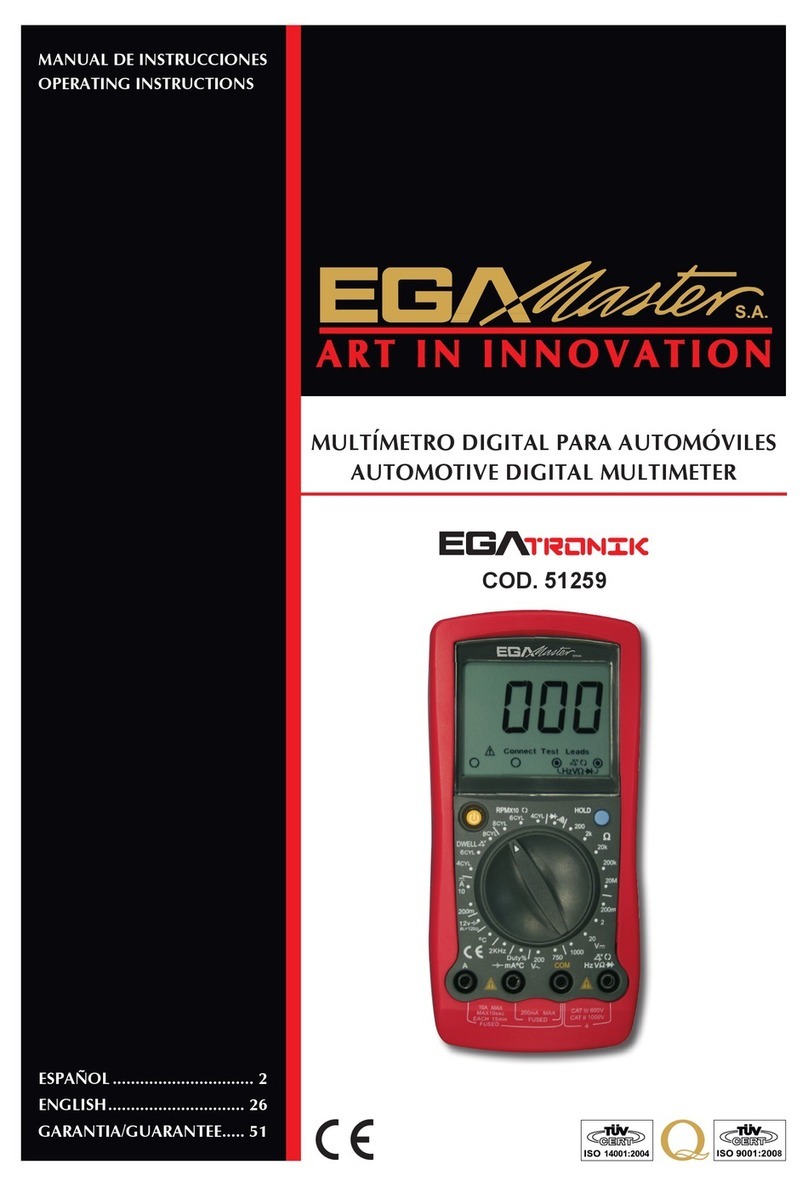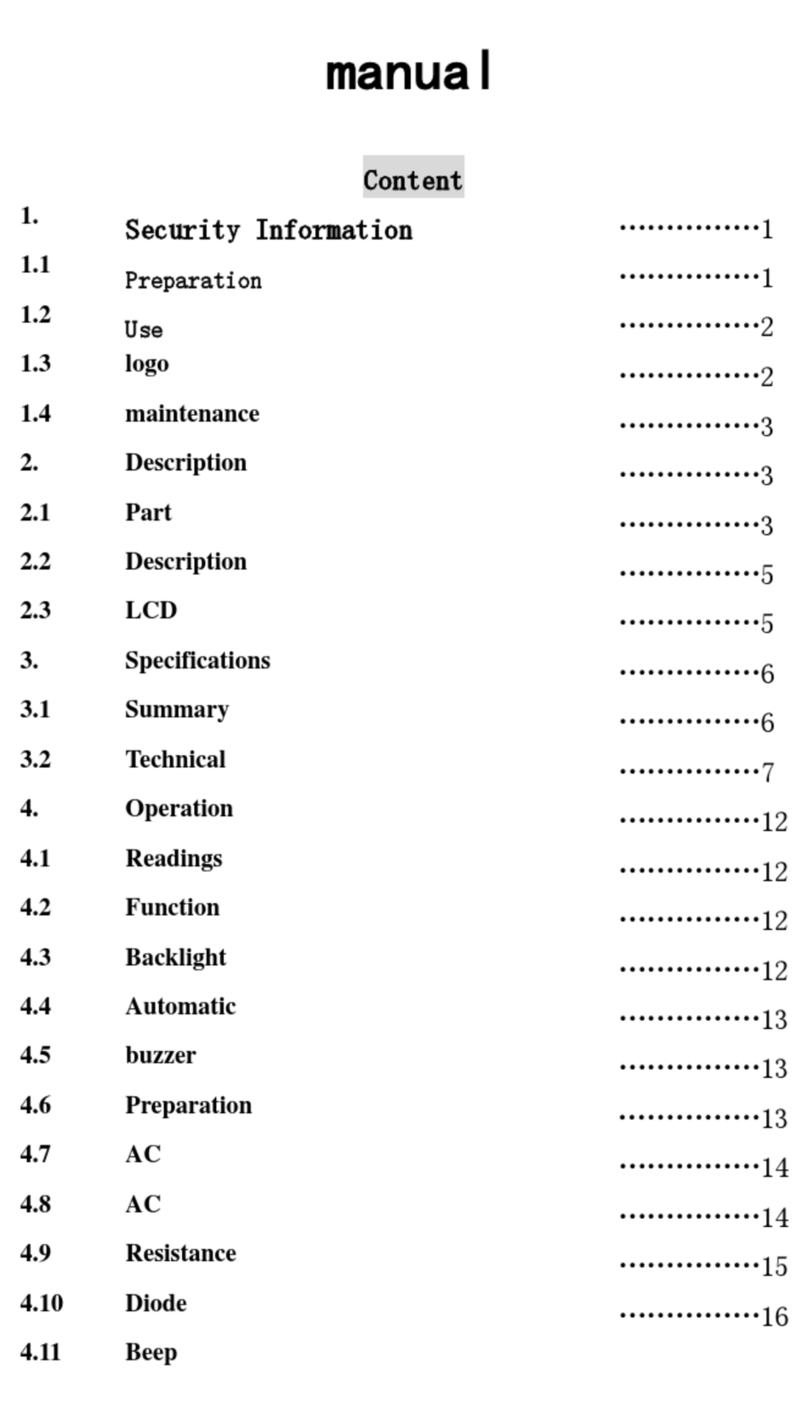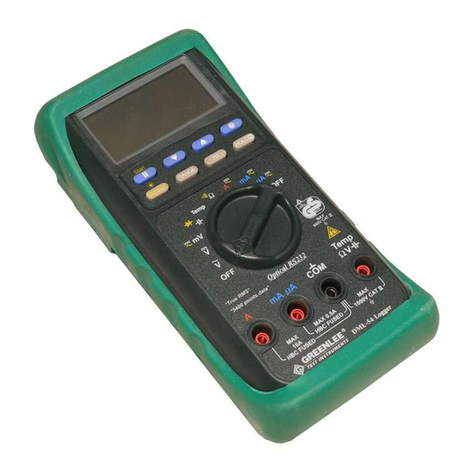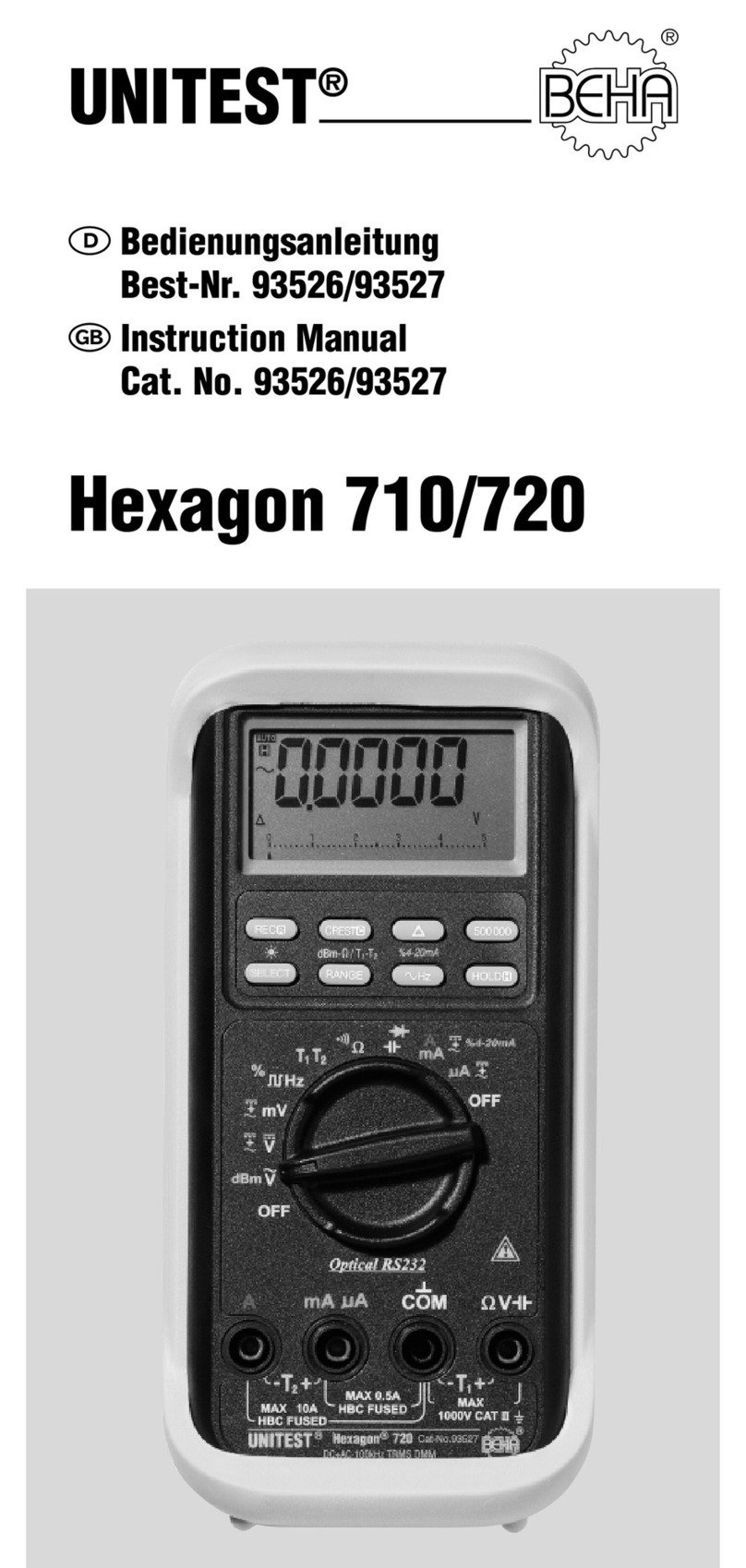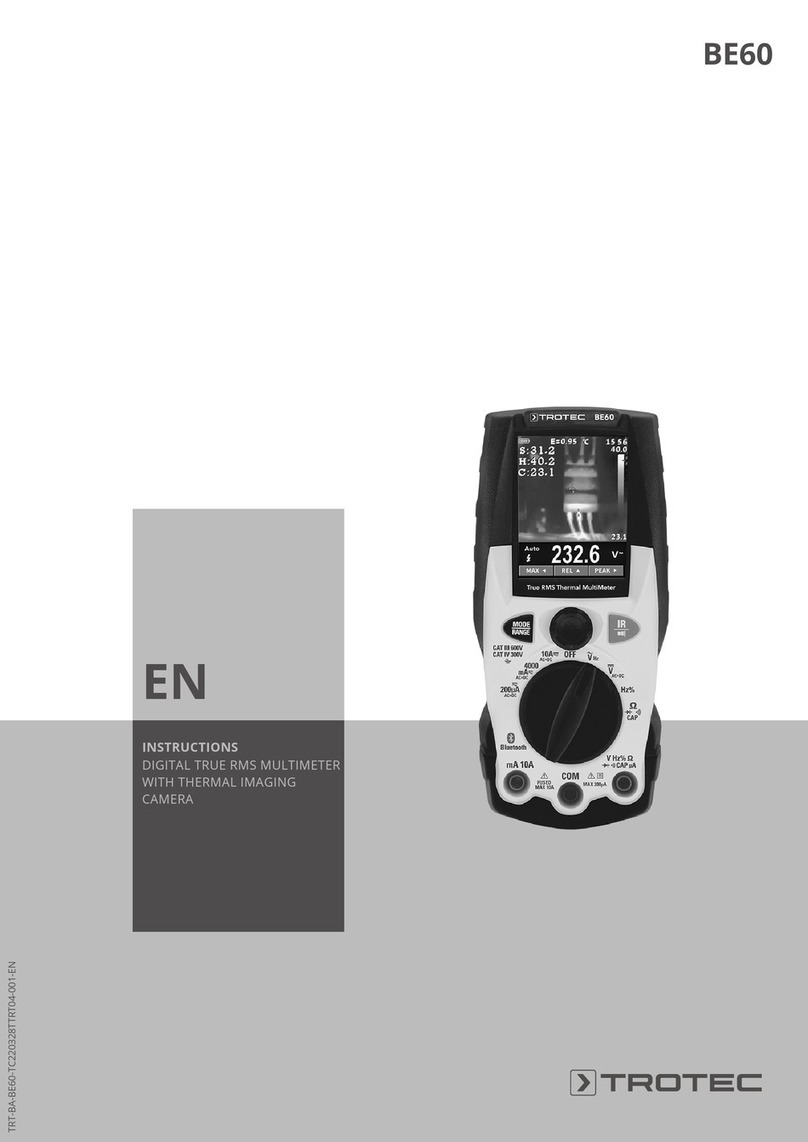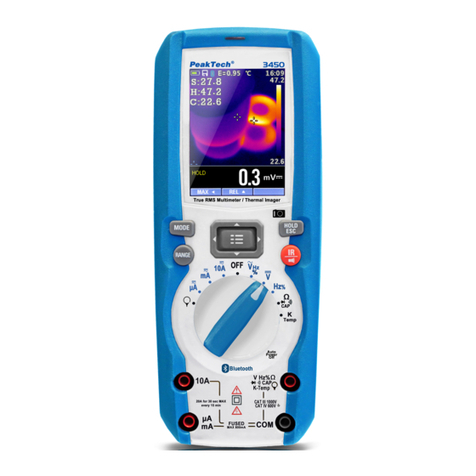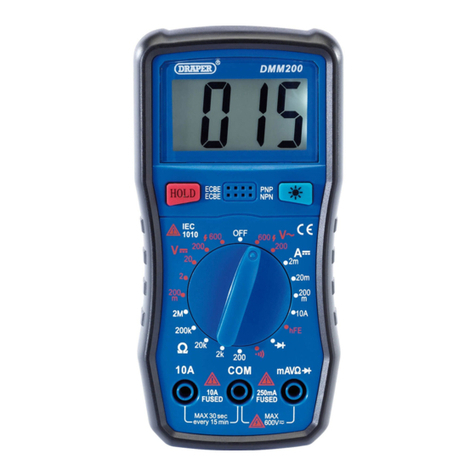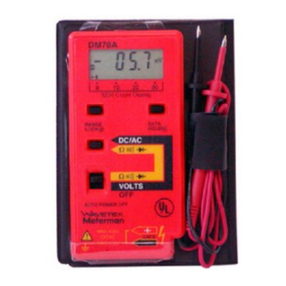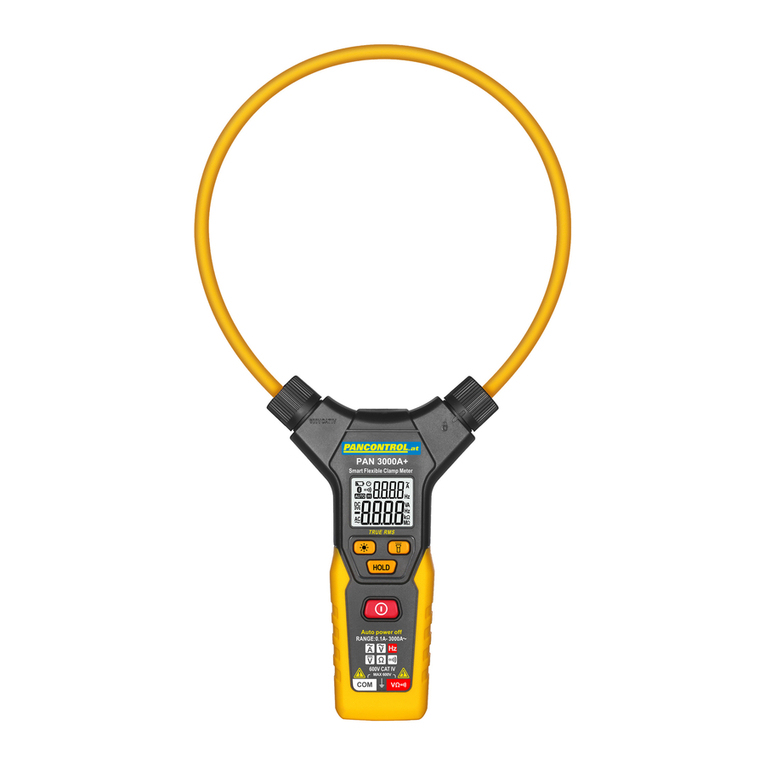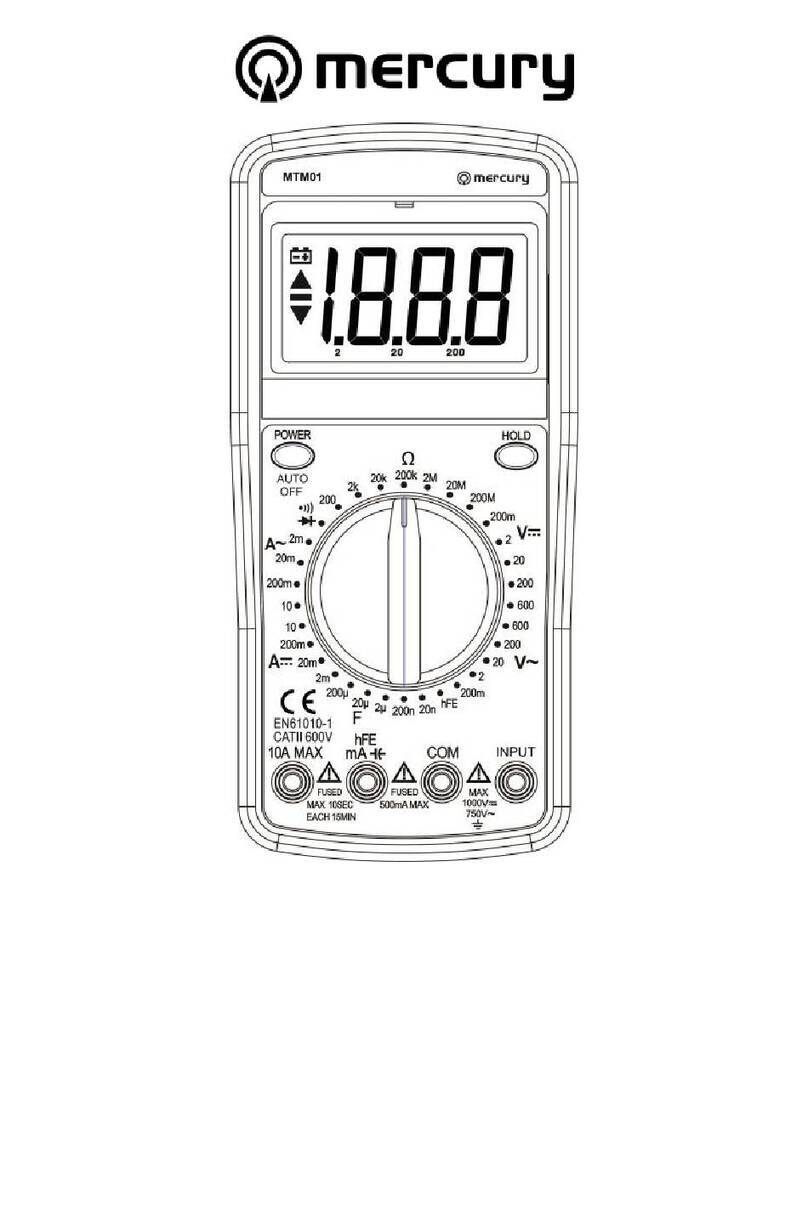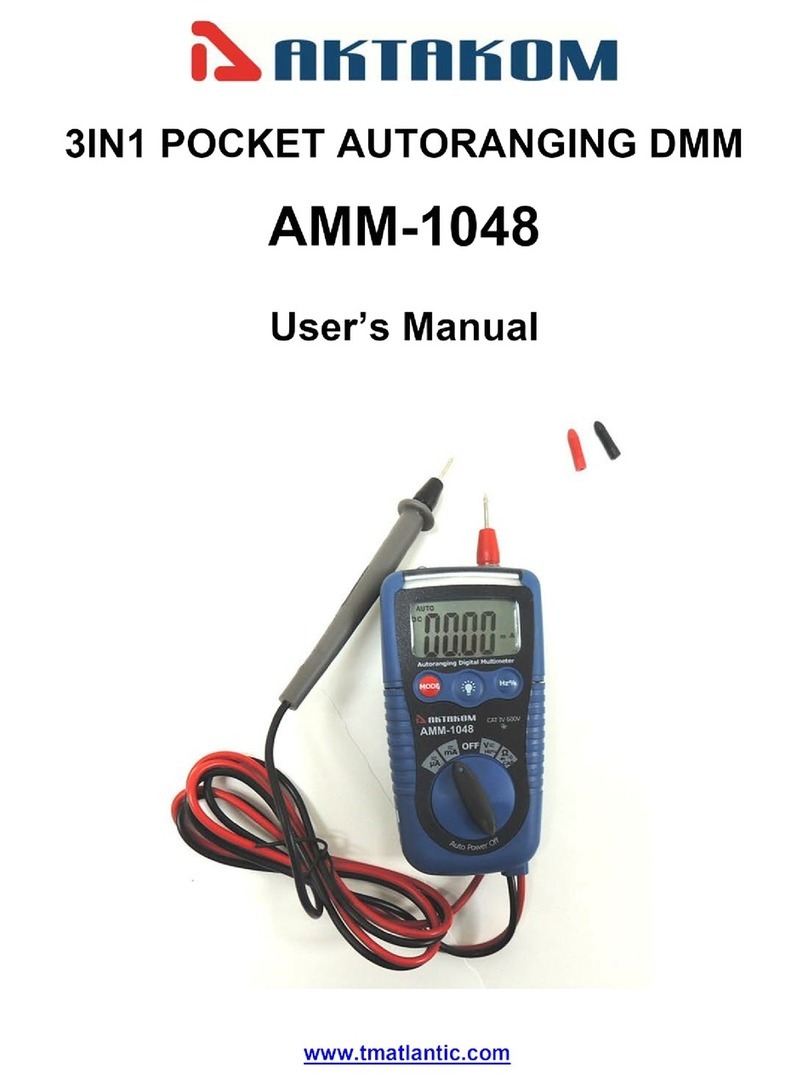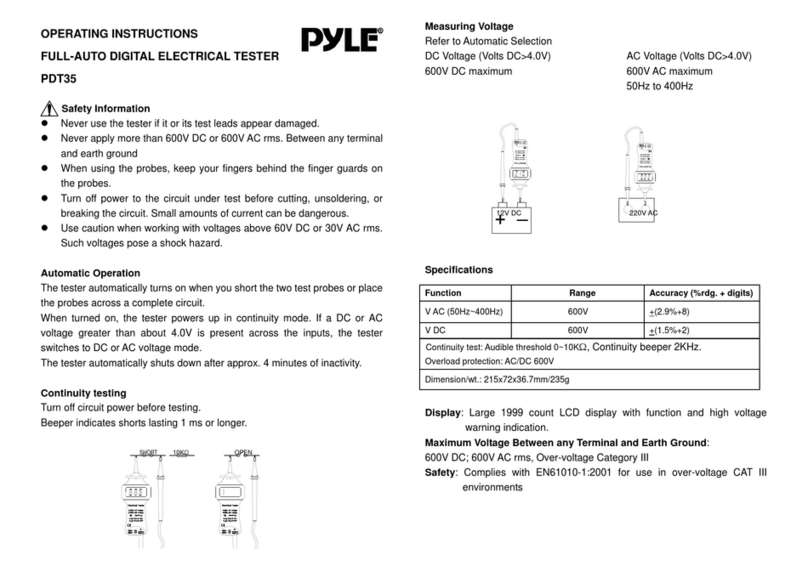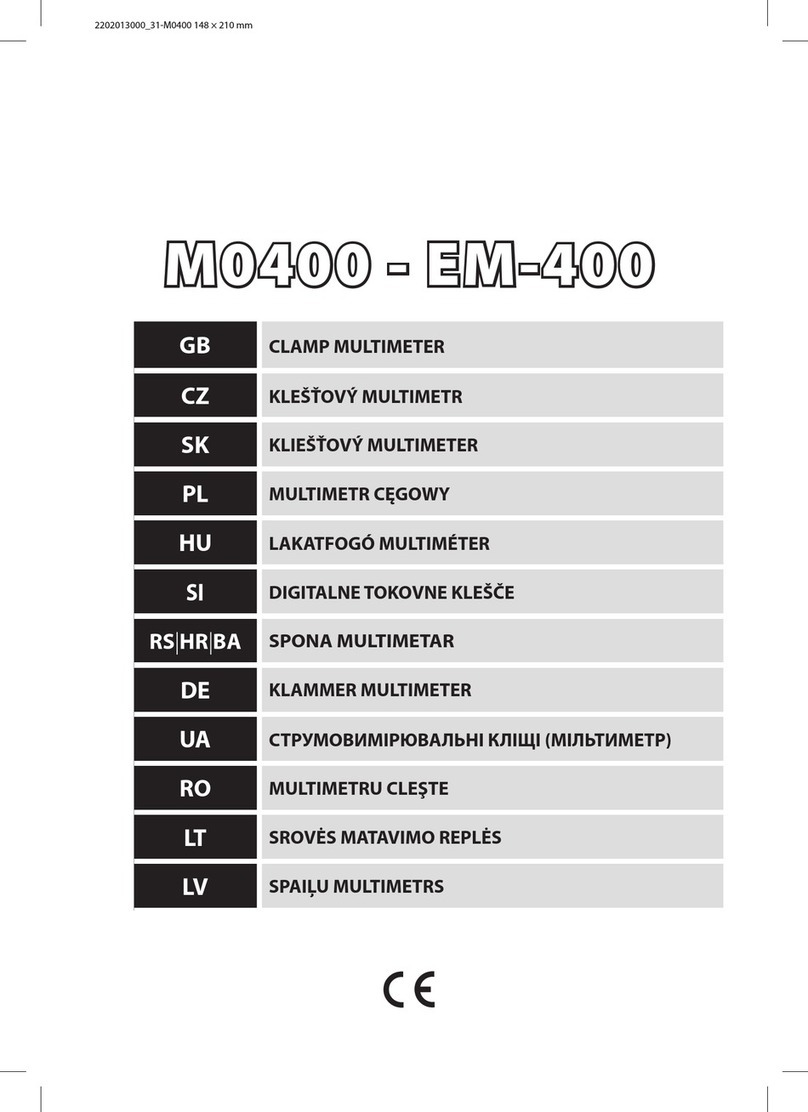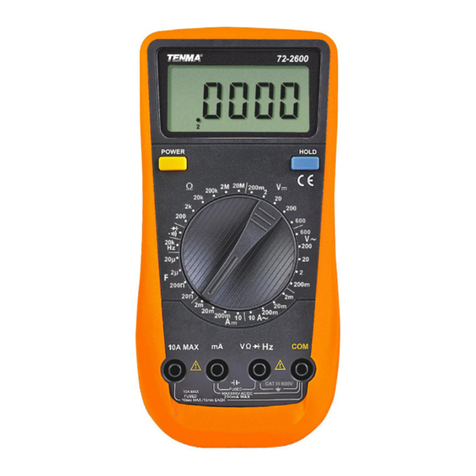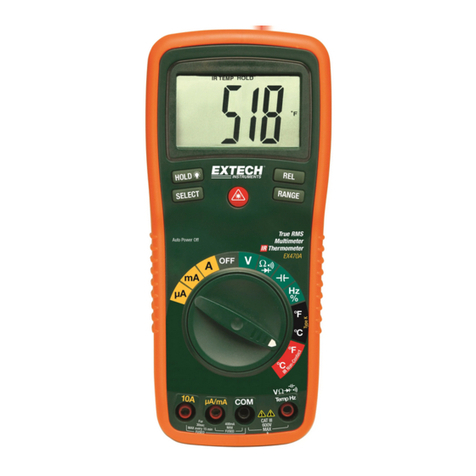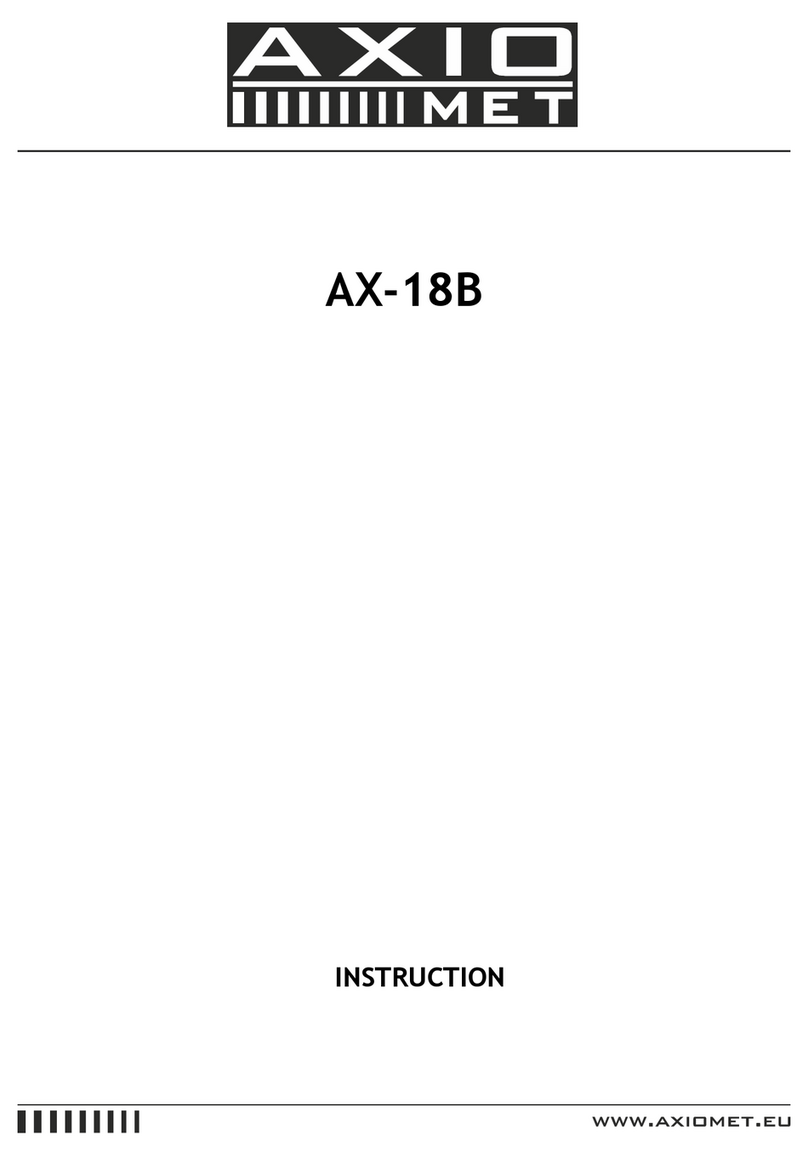EGAmaster EgaTronic COD.58515 User manual

MULTIMETER
OPERATING INSTRUCTIONS
GUARANTEE........................ 21
COD.58515

2
OVERVIEW
To avoid electric shock or personal injury, read the “Safety Information” and “Rules for Safety
Operation”carefully before using the Meter.
Digital Multimeters COD.58515 (hereafter referred to as “the Meter”) is 4 1/2 digits
with ex-large LCD, steady operations, fashionable structure and highly reliable hand-held
measuring instrument. The Meter uses large scale of integrated circuit with double integrated
A/D converter as its core and has full range overload protection. The Meter has 28 dierent
measuring functions. It has not only can measure AC/DC Voltage, AC/DC Current, Resistance,
Temperature, Capacitance,
Frequency, Transistor, Diode and Continuity, but also have Data Hold, Full Icon Display,
Overload Protection and Sleep Mode features.
UNPACKING INSPECTION
Open the package case and take out the Meter. Check the following items carefully to see
any missing or damaged part:
Item Description Qty
1 Operating Manual 1 piece
2 Test Lead 1 pair
3 Multi-Purpose Socket 1 piece
4 Point Contact Temperature Probe 1 piece
5 Holster 1 piece
6 9V Battery (NEDA 1604, 6F22 or 009P) 1 piece
In the event you nd any missing or damage, please contact your dealer immediately.
SAFETY INFORMATION
This Meter complies with the standards IEC61010: in pollution degree 2, overvoltage
category (CAT. II 1000V, CAT. III 600V) and double insulation.
CAT. II: Local level, appliance, PORTABLE EQUIPMENT etc., with smaller transient voltage
overvoltages than CAT. III.
ENGLISH

3
CAT. III: Distribution level, xed installation, with smaller transient overvoltages than CAT. IV
Use the Meter only as specied in this operating manual, otherwise the protection provided
by the Meter may be impaired.
In this manual, a Warning identies conditions and actions that pose hazards to the user, or
may damage the Meter or the equipment under test.
A Note identies the information that user should pay attention to.
International electrical symbols used on the Meter and in this Operating Manual are
explained on page 4.
RULES FOR SAFE OPERATION
Warning!
To avoid possible electric shock or personal injury, and to avoid possible damage to
the Meter or to the equipment under test, adhere to the following rules:
• Before using the Meter inspect the case. Do not use the Meter if it is damaged or the
case (or part of the case) is removed. Look for cracks or missing plastic. Pay attention to the
insulation around the connectors.
• Inspect the test leads for damaged insulation or exposed metal. Check the test leads for
continuity. Replace damaged test leads with identical model number or electrical specications
before using the Meter.
• Do not apply more than the rated voltage, as marked on the Meter, between the terminals
or between any terminal and grounding.
• The rotary switch should be placed in the right position and no any changeover of range
shall be made during measurement is conducted to prevent damage of the Meter.
• When the Meter working at an eective voltage over 60V in DC or 30V rms in AC, special
care should be taken for there is danger of electric shock.
• Use the proper terminals, function, and range for your measurements.
• If the value to be measured is unknown, use the maximum measurement position and
reduce the range stop by step until a satisfactory reading is obtained.
• Do not use or store the Meter in an environment of high temperature, humidity, explosive,
inammable and strong magnetic eld. The performance of the Meter may deteriorate after
dampened.
• When using the test leads, keep your ngers behind the nger guards.
• Disconnect circuit power and discharge all high-voltage capacitors before testing
resistance, continuity, diodes, capacitance or current.
• Before measuring current, check the Meter’s fuses and turn o power to the circuit before
connecting the Meter to the circuit.
• Replace the battery as soon as the battery indicator appears. With a low battery, the
Meter might produce false readings that can lead to electric shock and personal injury.
• Remove test leads and multi-purpose socket from the Meter and turn the Meter power o
before opening the Meter case.
• When servicing the Meter, use only the same model number or identical electrical
specications replacement parts.
• The internal circuit of the Meter shall not be altered at will to avoid damage of the Meter
and any accident.

4
• Soft cloth and mild detergent should be used to clean the surface of the Meter when
servicing. No abrasive and solvent should be used to prevent the surface of the Meter from
corrosion, damage and accident.
• The Meter is suitable for indoor use.
• Turn the Meter power o when it is not in use and take out the battery when not using for
a long time.
• Constantly check the battery as it may leak when it has been using for some time,
replace the battery as soon as leaking appears. A leaking battery will damage the Meter.
INTERNATIONAL ELECTRICAL SYMBOLS
AC (Alternating Current)
DC (Direct Current)
Grounding
Double Insulated
Deciency of Built-In Battery.
Warning. Refer to the Operating Manual
Diode
Fuse
Continuity Test
Conforms to Standards of European Union
THE METER STRUCTURE (see gure 1)
1__ LCD Display
2__ HOLD Button.
3__ Rotary Switch
4__ COM Input Terminal
5__ POWER
6__ Other Input Terminal.
7__ mA Input Terminal
8__ 20A Input Terminal
(gure 1)

5
ROTARY SWITCH
Below table indicated for information about the rotary switch positions.
Rotary Switch Position Function
DC voltage measurement
AC voltage measurement
hFE Transistor Test
AAC Current Measurement
DC Current Measurement
Fcx Capacitance Test
ºC Temperature Measurement
Hz Frequency Measurement
Diode test
Continuity test
ΩResistance measurement
FUNCTIONAL BUTTONS
Bellow table indicated for information about the functional button operations.
Button Operation Performed
Yellow Button
Turn the Meter on and o.
- Press down the POWER to turn on the Meter.
- Press up the POWER to turn o the Meter.
HOLD
Blue Button
-Press HOLD once to enter hold mode.
- Press HOLD again to exit hold mode.
- In Hold mode, is displayed and the present value is shown.
DISPLAY SYMBOLS (see gure 2)
(gure 2)

6
Nº Symbol Meaning
1
The battery is low.
Warning: To avoid false readings, replace the
battery as soon as the battery indicator
appears.
2 Warning Symbol
3AC Indicator for AC voltage or current.
The displayed value is the mean value.
4 Indicates negative reading
5 Test of diode
6The continuity buzzer is on
7 Date hold is active
8
Connect Terminal
Indicator of connecting test leads into dierent input
terminals.
9hFE The Unit of Transistor Test
10
mV, V V: Volts. The unit of voltage.
mV: Millivolt. 1 x 10-3 or 0.001 volts
Ω, kΩ, MG
Ω: Ohm. The unit of resistance
kΩ: kilohm. 1 x 103or 1000 ohms
MΩ: Megaohm. 1 x 106or 1.000.000 ohms.
µA,mA, A
A: Amperes (amps). The unit of current.
mA: Millliamp. 1 x 10-3 or 0.001 amperes.
µA: Microamp. 1x 10-6 or 0.000001 amperes.
ºC, ºF ºC: Centigrade temperature
ºF: Fahrenheit temperature
kHz Hertz. The unit of frequency in cycles/second.
Kilohertz. 1 x 103 or 1.000 hertz.
F, nF, µF
F: Farad. The unit of capacitance.
µF: Microfarad. 1 x 10-6 or 0.000001 farads.
nF: Nanofarad. 1 x 10-9 or 0.000000001 farads.

7
MEASUREMENT OPERATION
A. DC AND AC VOLTAGE MEASUREMENT (see gure 3)
(gure 3)
Warning!
To avoid harms to you or damages to the Meter from electric shock, never attempt to
measure voltages higher than 1000 or 1000V rms although readings may be obtained.
The DC Voltage ranges are: 200mV 2V, 20V, 200V and 1000V.
The AC Voltage ranges are: 2V, 20V, 200V and 1000V.
To measure DC Voltage, connect the Meter as follows:
1. Insert the red test lead into the VΩ input terminal and the black test lead into the COM
input terminal.
2. Set de rotary switch to an appropiate measurement position in or range.
3. Connect the test leads parallel across with the object to be measured.
The measured value shows on the display.
Note
• If de value of voltage to be measured is unknown, use the maximum measurement
position (1000V) and reduce the range step by step until a satisfactory reding is obtained.
• The LCD displays “1” indicating the existing selected range is overloaded , it is required
to select a higher range in order to obtain a correct reading.
• In each range, the Meter has an input impedance of approx. 10MΩ this loading eect can
cause measurement errors in high impedance circuits. If the circuit impedance is less than or
equal to 10kΩ the error is negligible (0.1% or less).
• When DC voltage measurement has been completed, disconnect the connection
between the testing leads and the circuit under test, and remove the testing leads away from the
input terminal of the Meter.

8
B. DC AND AC CURRENT MEASUREMENT (see gure 4)
(gure 4)
Warning!
Never attempt an in-circuit current measurement where the open circuit voltage
between terminals and ground is greater than 60V DC or 30V rms in AC.
If the fuse burns out during measurement, the Meter may be damaged or the operator
himself may be hurt. Use proper terminals, function, and range for the measurement.
When the testing leads are connected to the current terminals, do not parallel them
across any circuit.
The DC Current Measurement has 3 measurement positions on the rotary switch: 2mA,
200mA and 20A.
The AC Current Measurement has 3 measurement positions on the rotary switch: 20mA,
200mA and 20A.
To measure current, do the following:
1. Turn o power to the circuit. Discharge all high-voltage capacitors.
2. Insert the red test lead into the 20A or mA input terminal and the black test lead into the COM
terminal.
When you measure current below 200mA, please insert the red test lead into the mA input
terminal. When you measure 200mA or above, insert the red test lead into the 20A input
terminal.
3. Set the rotary switch to an appropriate measurement position in or range.
4. Break the current path to be tested. Connect the red test lead in serial to the more positive
side of the break and the black test lead to the more negative side of the break.
5. Turn on power to the circuit.
The measured value shows on the display.

9
Note
• l If the value of current to be measured is unknown, use the maximum measurement
position, and reduce the range step by step until a satisfactory reading is obtained.
• l For safety sake, the measuring time for high current should be less than 10 seconds
and the interval time between 2 measurements should be greater than 15 minutes.
• l When current measurement has been completed, disconnect the connection between
the testing leads and the circuit under test, and remove the testing leads away from the input
terminal of the Meter.
C. MEASURING RESISTANCE (see gure 5)
(gure 5)
Warning!
To avoid damages to the Meter or to the devices under test, disconnect circuit power
and discharge all the high-voltage capacitors before measuring resistance.
The resistance ranges are: 200Ω, 2kΩ, 20kΩ, 2MΩ and 200MΩ.
To measure resistance, connect the Meter as follows:
1. Insert the red test lead into the VΩ input terminal and the black test lead into the COM
terminal.
2. Set the rotary swich to an appropriate measurement position in Ωrange.
3. Connect the test leads parallel across with the object being measured.
Note
• The test leads can add 0.1Ω to 0.3 of error to the slow-resistance (200Ω) measurement.
• For high resistance (>1MΩ), it is normal taking several seconds to obtain a stable
reading.
• When there is no input, for example in open circuit condition, the Meter displays “1”.
• When resistance measurement has been completed, disconnect the connection between
the testing leads and the circuit under test, and remove the testing leads away from the input
terminal of the Meter.

10
D. MEASURING DIODES AND CONTINUITY (see gure 6)
(gure 6)
Warning!
To avoid damage to the Meter or to the equipement under test, disconnect circuit
porwer and discharge all high-voltage capacitors bere measuring diodes.
To avoid harms to you, never attempt to input voltages higher than 60V DC or 30V rms
in AC.
Measuring Diodes:
Use the diode test to check diodes, transistors, and other semiconductor devices. The diode
test sends a current through the semiconductor junction, and then measures the voltage drop
across the junction. A good silicon junction drops between 0.5V and 0.8V.
To test out a diode out of a circuit, connect the Meter as follows:
1. Insert the red test lead into the VΩ input terminal and the black test lead into the COM
terminal.
2. Set the rotary swich to .
3. For forward voltage drop readings on any semiconductor component, place the red test lead
on the component’s anode and place the black test lead on the component’s cathode.
The measured value shows on the display.
Note
• In a circuit, a good diode should still produce a forward voltage drop reading of 0.5V to
0.8V; however; the reverse voltage drop reading can vary depending on the resistance of other
pathways between the probe tips.
• Connect the test leads to the proper terminals as said above to avoid error display. The
LCD will display “1” indicating open-circuit for wrong connection. The unit of diode is Volt (V),
displaying the positive-connection voltage-drop value.
• The open-circuit voltage is around 3V.
• When diode testing has been completed, disconnect the connection between the testing
leads and the circuit under test, and remove the testing leads away from the input terminal of
the Meter.

11
Testing for Continuity
To test for continuity, connect the Meter as below:
1. Insert the red test lead intoV terminal and the black test lead into the COM terminal.
2. Set the rotary switch to .
3. Connect the test leads across with the object being measured.
4. The buzzer does not sound if the resistance of a circuit under test is ≤70Ω. The tested circuit
resistance value simultaneously shows on the display and the unit is Ω.
Note
When continuity testing has been completed, disconnect the connection between the testing
leads and the circuit under test, and remove the testing leads away from the input terminal of
the Meter.
E. FREQUENCY MEASUREMENT (see gure 7)
(gure 7)
Warning!
To avoid harms to you, never attempt to input voltages higher than 60V DC or V rms
in AC. When the voltage of tester frequency signal is higher than 30V rms, the reading
obtained may not be without the accuracy.
The frequency measurement range is 20kHz. To measure frequency, connect the Meter as
follows:
1. Insert the read test lead into the VΩterminal and the black test lead into the COM
terminal.
2. Set the rotary switch to 20kHz range.
3. Parallel connect the test leads across with the object being measured.
The measured value shows on the display.
Note
When Hz measurement has been completed, disconnect the connection between the testing
leads and the circuit under test, and remove the testing leads away from the imput terminals of
the Meter.

12
F. TEMPERATURE MEASUREMENT (see gure 8)
(gure 8)
Warning!
To avoid harm to you or damages to the Meter, never attempt to measure voltages
higher than 60V in DC or 30V rms in AC although readings may be obtained.
During testing, the operating temperature must be within 18-23o C, otherwise the
obtained reading may not be correct especially measuring low temperature.
The temperature measurement range is from -40Cº~1000Cº.
To measure temperature, connect the Meter as follows:
1. Insert the “+” and “-“ temperature probe into corresponding VΩand COM terminal.
2. Set the rotary switch to ºC.
3. Place the temperature probe’s tip to the object being measured.
The measured value shows on the display.
Note:
• When there is no temperature probe insert inside the Meter, the LCD displays the Meter
inside temperature.
• The included temperature probe can only be measured up to 250ºC. For any
measurement higher than that, the rod type temperature probe must be used instead.
When temperature measeuremnet has been completed, remove the temperature probe away
from the input terminal of the Meter.

13
G. CAPACITANCE MEASUREMENT (see gure 9)
(gure 9)
Warning!
To avoid damage to the Meter or to the equipment under test, disconnect circuit power
and discharge all high-voltage capacitors before measuring capacitance.Use the DC
voltage function to conrm that the capacitor is discharged.
To avoid harms to you, never attempt to input voltages higher than 60V DC or 30V rms
AC.
Capacitance measurement has 4 measurement positions on the rotary swich: 2nF, 20nF, 2µF
and 20µF.
To measure capacitance, connect the Meter as follows:
1. According to the size of the tested object’s leads, select multi-purpose socket or test clip to
insert into the mA and VΩterminal.
2. Set the rotary switch to an appropriate measurement position in Fcx range.
3. Insert the tested object into the corresponding jack of the multi-purpose socket or connect
the test clip to the object being measured.
The measured value shows on the display.
Note
• If the value of capacitance to be measured is unknown, use the maximum measurement
position, and reduce the range step by step until a satisfactory reading is obtained.
• When the tested capacitor is shorted or the capacitor value is overloaded, the LCD
display “1”.
• To minimize the measurement error caused by the distributed capacitor, the testing lead
should be as short as possible.
• To increase the accuracy especially when measuring small capacitance range, the
correct reading is subtracting the test lead open circuit value from the display value.

14
• It is normal to take a longer time when testing a high capacitor value.
• For testing the capacitor with polarity, connect the red clip or red test lead to anode and
black clip or black test lead to cathode.
• It takes some time for zeroing when you switching over the rotary switch, the oating
readings shows on the display during this process do not aect the nal testing accuracy.
• When capacitance testing has been completed, remove the testing leads away from the
multi-purpose socket, and remove multi-purpose socket or test clip away from the input terminal
of the Meter.
H. MEASURING TRANSISTOR (see gure 9)
Warning!
To avoid harms to you, please do not attempt to input voltages higher than 60V DC or
30V rms AC.
To measure transistor, connect the Meter as follows:
1. Insert the multi-purpose socket into the VΩand mA terminal.
2. Set the rotary switch to hFE range.
3. Insert the NPN or PNP type transistor to be tested into the corresponding jack of the multi-
purpose socket.
The measured nearest transistor value shows on the display.
Note
• When transistor measeurement has been completed, remove the transistor to be tested
away from the multi-purpose socket, and remove multi-purpose socket away from the input
terminal of the Meter.
SLEEP MODE
To preserve battery life, the Meter automatically turns o if you do not turn the rotary switch
or press any button for around 15 minutes. When the Meter is under sleep mode, it consumes
10µA current.
To activate the Meter, press POWER for two times.
OPERATION OF HOLD MODE
Warning!
To avoid possibility of electric shock, do not use Hold mode to determine if circuits are
without power. The Hold mode will not capture unstable or noisy readings.
To use the Hold mode as follows:
• Press HOLD to enter Hold mode.
• Press HOLD again to exit Hold mode.
• In Hold mode, is displayed.

15
GENERAL SPECIFICATIONS
• Maximum Voltage between any Terminals and grounding: Refer to dierent range input
protection voltage.
• Fused Protections for mA Input Terminal.
CE Version: 0.5A, 250V fast type, f 5x20mm.
VΩºC input jack’s fuse: 0.63A, 250V fast type, ɸ5x20mm, to be used on capacitance,
temperature and transistor testing input protection.
20A Input Terminal Unfused.
Maximum Display 19999, updates 2~3 times/second.
Range Manual ranging.
Polarity display Automatically.
Overloading Display “1”.
Battery Deciency Display “ ”.
Data Holding Display “ ”.
Temperature Operating: 0ºC ~40ºC (32ºF ~104ºF)
Storage: -10ºC ~50ºC (14ºF ~122ºF)
Relative Humidity ≤75% @ 0ºC~ below 30ºC
≤50% @ 30ºC~40ºC
Altitude Operating: 2000m; Storage: 10000m.
Electromagnetic Compatibility in a radio eld of 1 V/m,
Overall Accuracy = Specied Accuracy + 5% of Range;
in a radio eld of more than 1 V/m, no assigned accuracy
is specied.
Battery Type One piece of 9V (NEDA1604 or 6F22 or 006P).
Dimensions 179x88x39mm.
Weight Approx. 380g (including holster and battery)
Safety/Compliances IEC61010 CATII 10000V,
CATIII 600V overvoltage and
double insulation standard.
Certicate
ACCURACY SPECIFICATIONS
Accuracy ± (% reading + b digits), guarantee for 1 year
Operating temperature 18ºC~28ºC
Relative humidity ≤75%RH

16
A. DC Voltaje
Range Resolution Accuracy Overload Protection
200mV 0.01mV ±(0.05%+3) 250V DC / V AC
2V 0.0001V
±(0.1%+3) 1000V rms
20V 0.001V
200V 0.01V
1000V 0.1V ±(0.15%+5)
Remarks: Input Impedance: approx. 10MΩ.
B. AC Voltaje
Range Resolution Accuracy Overload Protection
2V 0.0001V
±(0.5%+10) 1000V rms
20V 0.001V
200V 0.01V
1000V 0.1V ±(1%+10)
Remarks:
• Input Impedance: approx. 2MΩ.
• Frequency response: 40Hz~400Hz.
• Displays eective value of sine wane (mean value response).
C. DC Current
Range Resolution Accuracy Overload Protection
2mA 0.0001mA ±(0.5%+5) CE Version: Fuse
0.5A, 250V, fast
type, Ф5x20mm
200mA 0.01mA ±(0.8%+5)
20A 0.001A ±(2%+10) Un-Fused
Remarks:
• At 20A Range: for continuous measurement ≤10 seconds and interval time
between 2 measurement greater than 15 minutes.
• Measuring Voltage Drop: Full Range is 200mV.
D. AC Current
Range Resolution Accuracy Overload Protection
20mA 0.0001mA ±(0.8%+10) CE Version: Fuse
0.5A, 250V, fast
type, Ф5x20mm
200mA 0.01mA ±(1.2%+10)
20A 0.001A ±(2.5%+10) Un-Fused
Remarks:
• Frequency reaponse: 40Hz~400Hz.
• At 20A Range: for continuous measurement ≤10 seconds and interval time
between 2 measurement greater than 15 minutes.
• Measuring Voltaje Drop: full range is 200mV.
• Displays eective value of sine wave (mean value response).

17
E. Resistance Test
Range Resolution Accuracy Overload Protection
200Ω0.01Ω
±(0.5%+10) + Test
Lead Short Circut
Resistance
250V rms
2kΩ0.0001kΩ
±(0.3%+1)
20kΩ0.001kΩ
2MΩ0.0001MΩ
200MΩ0.01MΩ±5% (reading-1000)
+ 10
Remarks:
• At 200mΩ testing leads is leads is shorted, the displays shows 1000 digit. To
obtain a correct reading, subtract these 1000 digits from the readings.
• To obtain accurate readings when measuring 200Ω short-circuit the testing
leads beforehand and record the reading obtained (called this reading as X).
(X) is the additional resistance from the test lead.
Then use the equation: measurement resistance value (Y) - (X)= accurate readings of
resistance.
F. Diodes and Continuity Test
Range Resolution Accuracy Overload Protection
Diodes 0.1mV
250V rms
Continuity Test 0.1Ω
Remarks:
• Open circuit voltage approx. 2.8V
• The buzzer does not sound if the resistance of a circuit under test is ≤70Ω.
G. Frequency
Range Resolution Accuracy Overload
Protection Sensitivity
20kHz 1kHz ±(1.5%+5) 250V rms ≤200mV
Remarks:
• The tested inductance: Q≥10, Internal resustance ≤1.3kΩ.
• When the tested inductance is >1H, the obtained reading is only for
reference.
H. Temperature
Range Resolution Accuracy Overload Protection
-40ºC~0ºC
1ºC
±(3%+40)
250V rms
0ºC~400ºC ±(1%+30)
400ºC~1000ºC ±(2%+50)

18
I. Capacitance
Range Resolution Accuracy Overload Protection
2nF 0.0001nF ±(3%+40)
250V rms
20nF 0.001nF
±(4%+10)2µF 0.0001µF
20µF 0.001µF
Remarks:
• Testing signal is approx.: 40Hz 40mVrms.
J. Transistor test
Range Resolution Testing Conditions Overload Protection
hFE 1lbo 10µA
Vce 2.8V 250V rms
Remarks:
• The display value is the tested transistor (NPN, PNP nearest value of hFE
(0~1000 ).
MAINTENANCE
This section provides basic maintenance information including battery and fuse replacement
instruction.
Warning
Do not attempt to repair or service your Meter unless you are qualied to do so
and have the relevant calibration, performance test, and service information.
To avoid electrical shock or damage to the Meter, do not get water inside the
case.
A. GENERAL SERVICE
l Periodically wipe the case with damp cloth and mild detergent. Do not use chemical
solvent.
l To clean the terminals with cotton bar with detergent, as dirt or moisture in the
terminals can aect readings.
l Turn the Meter o when it is not in use and take out the battery when not using for a
long time.
l Do not store the Meter in place of humidity, high temperature, explosive, inammable
and strong magnetic eld.

19
B. REPLACING THE FUSES (see gure 10)
(gure 10)
Warning
To avoid electrical shock or arc blast, or personal injury or damage to the Meter,
use specied fuses ONLY in accordance with the following procedure.
To replace the Meter’s fuse:
1. Turn the Meter o and remove all connections from the terminals.
2. Remove the holster from the Meter.
3. Remove the 3 screws from the case bottom, and separate the case top from the case bottom.
4. Remove the fuse by gently prying one end loose, then take out the fuse from its bracket.
5. Install ONLY replacement fuses with the identical type and specication and make sure the
fuse is xed rmly in the bracket.
Fuse 1: 0.5A, 250V, fast type, ɸ5x20mm
Fuse 2: 0.63A, 250V, fast type, ɸ5x20mm
6. Rejoin the case bottom and case top, and reinstall the 3 screws and holster.
Replacement of the fuses is seldom required. Burning of a fuse always results from improper
operation.

20
C. REPLACING THE BATTERY (see gure 10)
Warning
To avoid false readings, which could lead to possible electric shock or personal
injury, replace the battery as soon as the battery indicator “ ” appears.
To replace the Meter’s battery:
1. Turn the Meter power o and remove all connections from the terminals.
2. Remove the holster from the Meter.
3. Remove the 3 screws from the case bottom, and
separate the case top from the case bottom.
4. Remove the battery from the battery connector.
5. Replace with a new 9V battery (NEDA1604, 6F22 or 006P).
6. Rejoin the case bottom and case top, and reinstall the 3 screws and the holster
NOTES
IMPORTANT!
The maker will not take responsibility for damage or malfunction as a result of the device
being incorrectly used or, applied for a purpose for whith it was not intended.
According to Waste Electrical and Electronic Equipment directive (WEEE), these ones
must be collected and arranged separately. If you have to throw them out, please, do not use
the usual rubbish. Please, contact your distributor for free recycling.
GUARANTEE
The maker guarantees to the device owner 12 months against any manufacture defect.
This guarantee do not cover the parts wich are consumables.
Note: to apply the guarantee its necesary to send the “GUARANTEE CERTIFICATE” duly
lled within one week after purchased the machine to the maker.
Table of contents
Other EGAmaster Multimeter manuals

